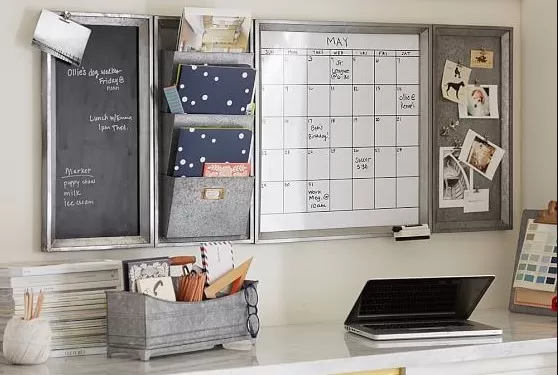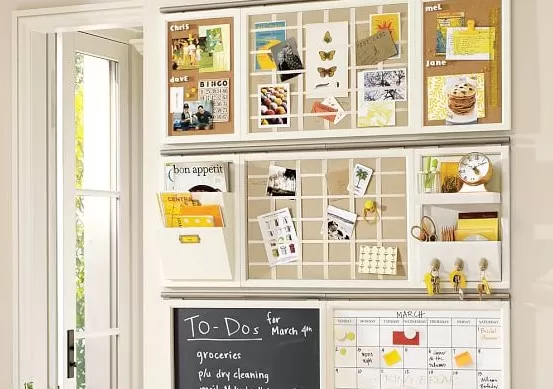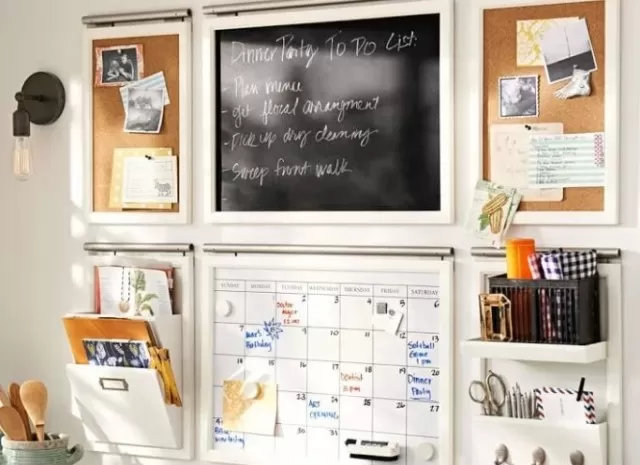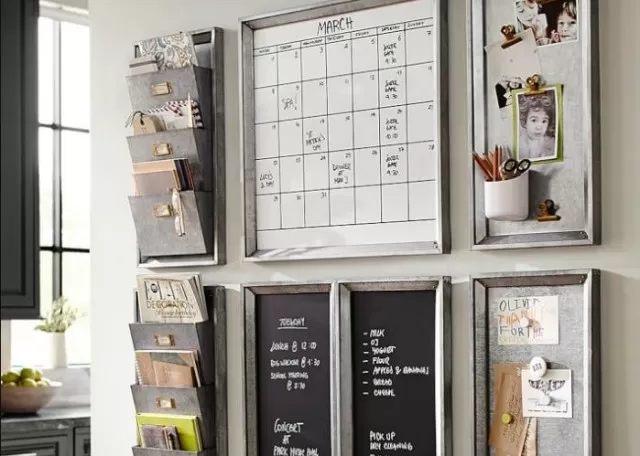The home command center has multiple functions, such as serving as a convenient drop zone near the door.
The home command center has multiple functions, such as serving as a convenient drop zone near the door, a designated area for sorting mail, storage space for office supplies, and a message board for reminders.
This versatile space needs to effectively handle various tasks, including managing the family calendar, organizing paperwork, and keeping track of notes and miscellaneous items in a structured and easily accessible manner. Setting up and maintaining an organized command center can be a challenge due to its many responsibilities.
Whether you aim to create an efficient kitchen hub or a compact entryway solution, these innovative ideas will assist you in designing a functional space that suits your family’s needs.
Home Command Center Organization Ideas

Simplify It.
Your command center doesn’t have to be overwhelming or extravagant.
You can easily create a straightforward yet efficient hub in your home. By the entryway, install a set of matching wall organizers that blend seamlessly with your decor.
A combination of chalkboards, baskets, and a few hooks is all you really need. Use the hooks for coats and bags, the baskets for incoming and outgoing mail, and the boards for memos.
Jot down reminders for yourself or family members about upcoming events or create a shopping list for your next store run.
With just a few wall storage solutions, you can transform your mudroom or entryway space into a productive family command center.
Hang a large bulletin board on a wall near the door to keep your calendar, artwork, and reminders in plain sight. Wall-mounted wire baskets with labels ensure that important papers are easily accessible, while a clock helps everyone stay on schedule.
Utilize Behind-the-Door Space.
When setting up a command center in a small entryway, every inch counts.
If you have limited wall space, incorporate various storage solutions and make use of every available inch, including the area behind a door. Hang a magnetic dry-erase board or chalkboard to post reminders as you rush out the door.
To maximize vertical space, combine a wall-mounted organizer with file boxes to store paperwork discreetly. You can also mount large bulldog clips on the wall to keep urgent papers in clear view.

Cooking Command Center.
Take your meal planning to the next level with this clever command center idea.
Transform the inside of a kitchen cabinet into a mini-hub for all things related to menu planning and meal preparation. Use a narrow peel-and-stick dry-erase weekly calendar to brainstorm meal ideas.
Hang a notepad for creating shopping lists. Attach basic cooking guides, such as ingredient substitutions and measurement conversions, to save time and keep your kitchen organized, making it easier to get dinner on the table.
Streamlined Schedules.
A classic black-and-white command center above your desk maintains a neat and orderly appearance while exuding a sleek look.
Coordinate memo boards and calendars to organize monthly schedules and weekly menus. Include a small space for jotting down reminders.
Hang clipboards for to-do lists and grocery shopping lists, as well as chore charts. Use the magazine holders below to corral mail, paperwork, and books that need to be returned.
Make It Interactive.
Involve the entire family in scheduling with this interactive command center idea.
Hang a larger-than-life dry-erase calendar on an empty wall to ensure that no one forgets soccer practice or dance recitals. Provide a cup with markers and have a quick gathering at the beginning of each month where everyone can add their events or reminders.
Assign a different color to each family member for better organization. Magnetic clips allow you to hang invitations, photos, or notes for one another.
Chalkboard Command Center.
Elevate the interactive approach to organizing with a chalkboard that spans an entire wall.
Transform an empty wall into a giant blackboard using chalkboard paint. Draw outlines for calendars and leave inspirational notes or drawings for family members or guests.
Mount a floating shelf to serve as a drop zone or a space for working. Slide some comfortable stools underneath the ledge for an easy workspace.

Look Ahead.
Busy families require extensive organization and planning.
While a monthly dry-erase calendar is useful for staying on top of things, it’s easy to overlook events in the upcoming month. If your kids are involved in numerous sports and school activities, and you have schedules stretching into the next season, consider incorporating two calendars into your command center—one for the current month and one for the month ahead.
On the same wall, give each child a hanging file pocket, making it magnetic to prevent the loss of smaller memos and mementos.
Conceal Command Center Clutter.
A tall, shallow cabinet in the kitchen or laundry room can serve as an ideal location for the family headquarters.
Transform this space into a camouflaged command center that can be easily hidden away. Install a small rack for hanging keys and individual hooks for hats and totes.
A high shelf can house emergency supplies like flashlights or extra chargers. Add a slim memo board to the inside of the cabinet door and include an organizer for holding writing utensils and sticky notes.
Think Outside the Entryway.
Family command centers don’t have to be limited to main hallways or areas near the front door.
With a small cabinet and floating shelves, you can transform a corner of your dining room into a clever storage hub. Use a wire file sorter to organize paperwork, and include a charging station to manage cords.
Keep the countertops clear for bill payments and mail sorting. Use the cabinet to store crafting and office supplies out of sight, while a magnetic dry-erase board above can host reminders and family photos.

Make the Most of Tight Corners.
Convert an unused corner into a space-saving command center.
This one-wall storage solution maximizes the side of a built-in fridge. Create custom wood folders to form a vertical filing system for mail, catalogs, homework, and newspapers.
Label each section and use folders to keep items sorted by purpose. Include a small corkboard for posting reminders.
Give the Pantry Another Purpose.
The pantry is a space that family members use daily, so why not give it a dual purpose by storing favorite snacks alongside your meal schedule? Suspend a couple of weekly calendars near the doorframe to plan out your menu.
Include notes such as defrosting instructions or scheduling conflicts that might affect dinner time. Add a memo board for hanging a grocery shopping list or the kids’ school lunch schedule.
Mounted baskets can hold pens, scissors, and even a label maker for marking expiration dates on decanted pantry goods.
Hide a Command Center in a Cabinet.
For a more streamlined solution, create a hidden command center inside a cabinet or buffet.
This saves wall space and prevents unsightly papers from cluttering your living area. Stack plastic bins or drawers inside the cabinet to store paperwork and school projects.
Label each one with sticker letters to designate a spot for each family member. Attach magnetic strips to the inside of the door to hold memos and notes.
Put Small Walls to Work.
Small walls that may serve minimal purposes are ideal for creating a family command center.
Choose a small section of wall in a central area of your home, such as the entryway or mudroom, and optimize it with a few simple updates. Install a set of wall hooks to make keys easily accessible when leaving the house.
Hang a magnetic or bulletin board to display photos, invitations, or mail. For added functionality, apply dry-erase peel-and-stick wallpaper to create a surface for writing notes and reminders.
*The information is for reference only.